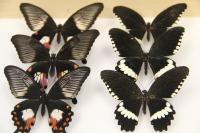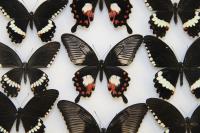
Papilio polytes, an Asian swallowtail butterfly species also known as the Common Mormon, possesses distinctive mimicry patterns (left). The same species also has non-mimetic forms (right). A single gene regulates the complex wing patterns, colors and structures required for mimicry in swallowtail butterflies, report scientists from the University of Chicago, March 5 in Nature. Surprisingly, the gene described, doublesex, is already well-known for its critical role in sexual differentiation in insects.
"Conventional wisdom says that it should be multiple genes working together to control the whole wing pattern of a butterfly," said Marcus Kronforst, Neubauer Family Assistant Professor of Ecology & Evolution at the University of Chicago and senior author of the study. "But in this case, it's just this one. This single gene that controls sexual differentiation has been co-opted to do a totally new job."
Studied as an example of natural selection for centuries, wing pattern mimicry in butterflies enables non-toxic species to mimic the pattern, color and shape of a toxic species' wings to deter predation. A single region of the genome regulates this process in some swallowtail butterflies. Due to the complexity of forms involved with mimicry, researchers have assumed this region contained a "supergene"—multiple tightly-linked genes, each controlling a subset of the wing pattern. However, little was known about this hypothesized mimicry supergene. 
Some female Papilio polytes butterfly display colors and patterns that mimic the wings of a toxic butterfly species (center column).
To identify its function, Kronforst and his team studied Papilio polytes, an Asian swallowtail butterfly species that displays sex-limited mimicry. Females possess one of four different wing patterns, three of which mimic toxic species, while the remaining female form and all males remain non-mimetic.
Through a genetic mapping process that involved mating butterflies of differing wing patterns and comparing the genomes of around 500 offspring, the team identified five possible genes involved in mimicry. They then sequenced the genomes of 30 butterflies, evenly split between mimetic and non-mimetic, and looked for correlations between these specific genes and wing pattern.
To their surprise, only one, doublesex, showed an association. Well established as a gene that controls sexual differentiation in insects, doublesex functions through alternative splicing. When copied into messenger RNA, it is cut and rearranged into different isoforms, which then go on to instruct cells whether they should be male or female. 
This photo shows the expression of doublesex protein (green) during development mirrors the future wing pattern of an adult Papilio polytes butterfly.
Kronforst and his team found that doublesex is also alternatively spliced into multiple isoforms in Papilio polytes. Two in particular were expressed at extremely high levels in the wings of mimetic butterflies when compared to non-mimetic females. Tracing the doublesex protein from caterpillar to chrysalis to butterfly, the team found expression of doublesex overlaps exactly with wing pattern.
"When you look at the wing tissue in a chrysalis five days after it forms the pupa, it's just a floppy piece of white tissue," Kronforst said. "But when you look at where doublesex is being manufactured on the wing, it looks just like the future adult wing pattern."
How one gene controls so many different functions remains unclear. Kronforst suggests that noncoding, regulatory DNA that controls when and where doublesex is expressed may play a role. The team also found that in mimetic butterflies, the doublesex gene is inverted on the genome. This inversion eliminates the possibility of recombination—alleles will remain distinct from each other and accumulate differing mutations. This has led to structural differences in the doublesex protein between mimetic and non-mimetic butterflies. Because doublesex is a transcription factor and activates other genes, the researchers believe these differences may also contribute to wing pattern variation.
"We've illustrated the genetic basis of female-limited mimicry in these butterflies," said Wei Zhang, PhD, postdoctoral fellow at the University of Chicago and a lead study author. "But this is just the first step. How doublesex became involved in this process is still uncertain, and requires further study."
Study lead author Krushnamegh Kunte, PhD, of the National Center for Biological Sciences in Bengaluru, India, and a former postdoctoral fellow in the Kronforst lab, anticipates future research will determine if this type of phenomenon will be found in other species. "Across animal species, we find examples where polymorphisms occur in one sex or the other," he said. "We're studying it in the context of mimicry, but it's possible that this sex differentiation pathway that we found in butterflies could be a pathway that's more broadly important for sex-limited polymorphism." Source : kevin.jiang@uchospitals.edu
 Print Article
Print Article Mail to a Friend
Mail to a Friend
